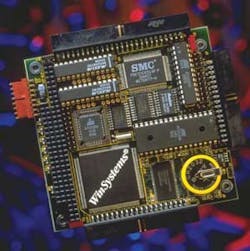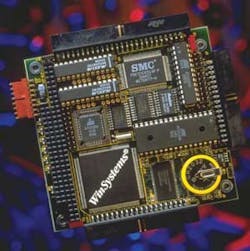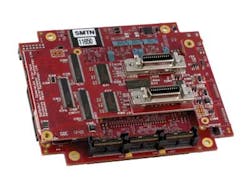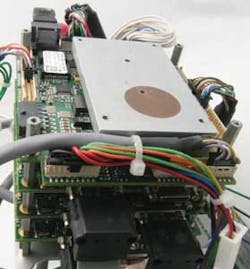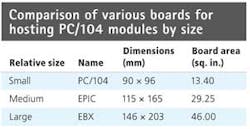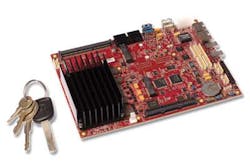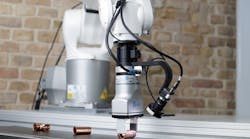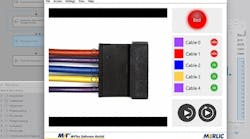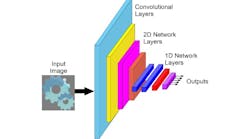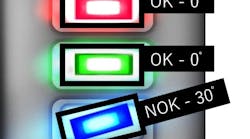Andrew Wilson, Editor
With the introduction of the IBM PC, developers found that by leveraging numerous imaging, I/O, and data acquisition boards, application-specific systems could be rapidly configured. For those wishing to build smaller embedded systems, the introduction of the PC/104 standard allowed similar types of peripheral cards to be stacked together in a smaller form factor. Using CPU, digital I/O, data acquisition, and image capture boards from multiple vendors, scientific, machine-vision, medical, and military systems with small footprints can be developed at low cost.
The history of the PC/104 architecture closely follows that of the personal computer. Originally created by Ampro—now Ampro ADLINK Technology and introduced as a standard by the PC/104 Consortium (www.pc104.org) in 1992—the original specification used the same signal definitions as originally used on the IBM PC with added ground pins.
To remain compatible with the IBM PC's original architecture, the PC/104 standard uses 64- and 40-position connectors that replace the standard 62 and 36 positions (P1 and P2 edge-card connectors of the PC)—hence the name PC/104. A copy of the PC/104 specification can be found at http://bit.ly/VTGDn7. Although not recommended for new designs, the PCM-SX 386SX single-board PC from Win Systems illustrates the PC/104 concept (see Fig. 1).
Adding peripherals
Just as the PC evolved to support higher bus transfer speeds, so did the PC/104 standard. After Intel introduced the peripheral component interconnect (PCI) bus, the standard was rapidly adopted by PC motherboard manufacturers wishing to allow I/O peripherals such as modems and disk controllers to transfer data over a 32-bit bus at peak data rates of 133 Mbytes/sec.
Realizing the benefits of this, the PC/104 Consortium introduced an embedded version of this interconnect bus known as PC/104-Plus. However, rather than use the 124-pin edge connector of the PCI bus, PC/104-Plus uses a 120-pin stack-through connector, an electrical interface that does not support 64-bit extensions, JTAG, PRSNT, or CLKRUN signals. A copy of the PC/104-Plus specification can be found at http://bit.ly/XOYY65.
Because the PCI specification is suited to high-speed data transfer, many manufacturers have introduced frame grabber boards for the standard. RTD Embedded Technologies, for example, has developed a dual-channel frame grabber, the VFG7330ER, around the PC/104-Plus standard. Supporting NTSC, PAL, and SECAM inputs, the frame grabber allows simultaneous video decoding on two input channels. The PC/104-Plus board incorporates both the PC/104 XT and AT bus connector and the 120-pin PCI bus. Since the mechanical dimensions of the board match that of the original PC/104 specification, PC/104-Plus boards are thus form-factor compliant.
Increasing speed
Although a number of manufacturers still incorporate the original XT/AT (a.k.a. ISA) connector on their products, these have been superseded by products that simply incorporate the PCI interface. This standard, known as PCI/104, has been used by MEN Mikro Elektronik in the design of its PP1-PCI-104 COM module that features a 384-MHz PowerPC, 128 Mbytes of SDRAM, and 16 Mbytes of flash memory.
Because the board does not incorporate the ISA interface, manufacturers such as MEN Mikro Elektronik can use the increased real estate to add functionality to their products. Although 120 pins are used in the PCI interface, the PC/104 Consortium retained the "104" moniker.
In the development of its 4Sight X industrial imaging computer, Matrox Imaging has leveraged this modular concept to allow various types of the PCI/104 frame grabber boards to be integrated onto the company's 4Sight X motherboard. This allows numerous types of analog and digital camera interfaces to be used with the system.
Point to point
While the PCI interface is a shared parallel-bus architecture, like the preceding PC/XT/AT architecture it has been superseded by PCI-Express, a point-to-point serial topology. To use this high-speed bus in embedded applications, the PC/104 Consortium has developed two standards: PCI/104-Express and PCIe/104. While the PCI/104-Express standard incorporates the PCI-Express interface and PCI interface, boards designated as PCIe/104 simply incorporate the PCI-Express interface.
In the PCI-Express interface for PC/104, a bank of three PCI connectors with 156 pins is used. For backward compatibility with PCI/104, PC/104-Plus, and peripherals, the PCI/104-Express standard also retains the 120-pin PCI connector.
An example of a PCI/104-Express board is the Microspace MSMG104EX/A PCI/104-Express frame grabber from Kontron. Since the board incorporates four BT848 video digitizers, each capable of handling four video inputs, up to 16 NTSC/PAL-standard based cameras can be interfaced to the board. These are then interfaced to the PCI/104-Express bus over a PCI-to-PCIe bridge. As well as supporting the PCI-Express interface, the board also supports standard PCI-compatible I/O devices through its PCI interface.
PCI/104-Express boards are also available that support digital camera interfaces such as Camera Link. The SMT149 frame grabber from Sundance Microprocessor Technology provides a Base, Medium, and Full configuration Camera Link interfaces using two MDR connectors (see Fig. 2). When using the Base Camera Link configuration, the board can allow two cameras to operate independently. It is possible to configure the second connector as a second Base Camera Link input.
To add processing capability to these embedded systems, developers can choose from a number of host PCIe/104 CPU boards. In the ADLQM67PC PCIe/104 board, ADL Embedded Solutions has chosen to integrate a 3-GHz Intel i7 quad-core CPU; up to 8 Gbytes of DRAM; a host of I/O interfaces including Ethernet, SATA, RS-232, and VGA output; and a bottom-stacking PCIe/104 connector. Figure 3 shows the board configured with two dual-port PCI/104-Express Camera Link frame grabbers from Active Silicon.
Bigger boards
While placing such a large amount of functionality on a 90 × 96-mm board is impressive, many embedded designers require even greater functionality. Because of this, the PC/104 Consortium has developed two single-board form factors known as EPIC (Embedded Platform for Industrial Computing) and EBX (Embedded Board, eXpandable). These boards, each with different dimensions, allow different types of "PC/104" modules to be added to a host single-board computer (see table).
To support the various types of boards, both the EBX and EPIC form factors are available in two configurations. While EBX boards support the traditional PC/104 ISA connector and the PC/104 PCI connector, EBX-Express boards use a PCIe connector and a PCI/104 PCI connector. EPIC and EPIC-Express boards are similarly configured. Specification for the EBX, EBX-Express, EPIC, and EPIC-Express standards are available at http://bit.ly/UMGzW9 and http://bit.ly/WrTHG7, respectively.
One example of such a CPU board is the Copperhead EBX single-board computer from Versalogic. With an Intel i7 processor, the board's features include sixteen analog inputs, eight analog outputs, and sixteen digital I/O lines. System I/O includes dual Gigabit Ethernet with network boot capability, two USB 3.0 ports, ten USB 2.0 ports, four serial ports, and HD audio (see Fig. 4). By leveraging such processing power, developers can now configure embedded machine-vision systems specifically tailored to multiple analog and digital camera interface standards while increasing performance and reliability.
In its 20-year history, the PC/104 Consortium has proved that as computer architectures have changed, so too must embedded architectures based on these standards. In the next 20 years, it will be interesting to watch as the PC/104 Consortium moves to embrace forthcoming standards for designers of embedded systems.
For further information on the PC/104 Consortium, visit www.pc104.org.
Companies Mentioned in this Article
Active Silicon
www.activesilicon.com
ADL Embedded Solutions
www.adl-usa.com.com
Ampro ADLINK Technology
www.adlinktech.com
Kontron
www.kontron.com
Matrox Imaging
www.matrox/imaging
MEN Mikro Elektronik
www.men.de
RTD Embedded Technologies
www.rtd.com
Sundance Microprocessor Technology
www.sundance.com
Versalogic
www.versalogic.com
Win Systems
www.winsystems.com
For comprehensive listings of frame grabber vendors, visit the Vision Systems Design Buyer's Guide (http://bit.ly/13zYQfy).
Vision Systems Articles Archives
